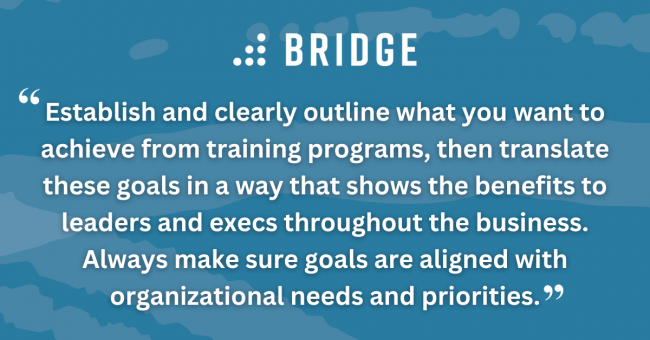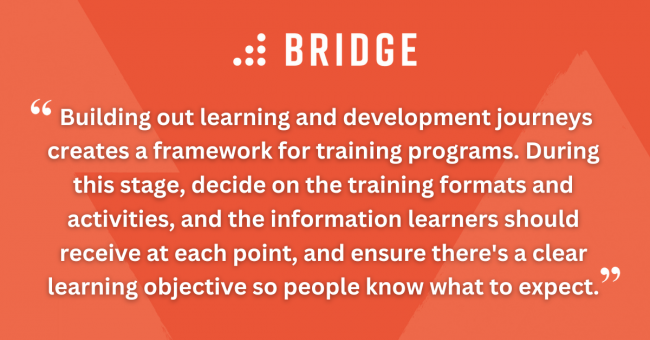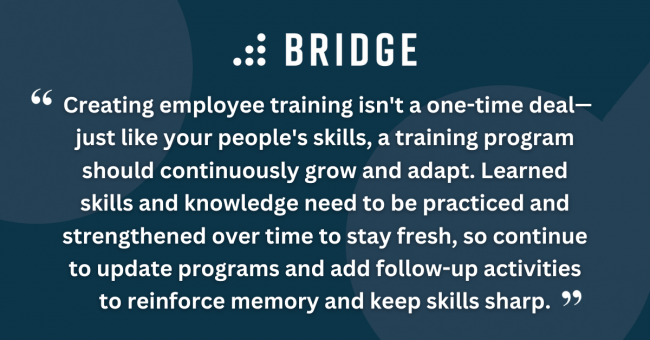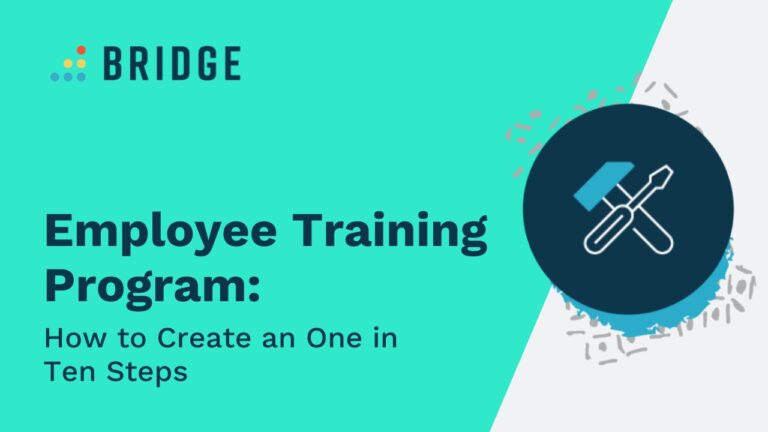An employee training program maps out the learning and development activities your people undertake as they build their knowledge and skills. When planned and executed effectively, these programs create a culture of continuous growth and help your organization achieve its strategic goals.
Employee development has never been more critical, and according to the findings from our joint report with HR.com, 62% of HR professionals of respondents say the number one factor driving learning in their organization is employee career development. What’s more, 58% expect learning technologies to better aid in the development of employees.
The success of your organization and its people goes hand in hand, and you achieve the best results with training programs that are well-planned and strategically aligned.
What Is an Employee Training Program?
A training program is the sequence of learning-based activities that your employees complete to reach well-defined, mutually beneficial learner/organizational goals.
Say an employee wants to move into a new role within your organization or advance into a more senior position. In this case, a training program might develop their technical knowledge, teach communication skills through role-playing, and periodically deliver assessments to test if they’re ready to take on their new responsibilities.
Equally, training programs can directly support organizational initiatives by building employee skills such as resilience.
The details of a training program should be outlined and communicated with a plan that includes details like the competencies and skills learners will gain, the end-goal, and the target audience.
10 Steps to Create and Implement an Effective Employee Training Program
The following steps will guide you through the process of creating a training program:
1) Define Your Employees’ Training and Development Needs
To connect employee skills with organizational priorities, you need to know what knowledge and abilities your people already possess, and the skills needed for organizational performance and growth. With this information, you can target skills gaps and prioritize upskilling and reskilling efforts.
When employees play an active role in deciding their development goals and training, they tend to be more invested. As findings from LinkedIn’s Workplace Learning report show, when employees have opportunities to learn, adapt, and grow, they’re more likely to be engaged and less likely to leave.
With an ongoing assessment of employee skills and the areas they want to develop via career discussions and informed by skills assessments and feedback, you’ll gain a more accurate view of evolving needs that you can connect to organizational performance goals.
Consider some of the following methods to assess employee training needs:
- Past performance review metrics and ratings
- Skills feedback from mentors, coaches, and peers
- Assessment scores and certifications
- Agendas from one-on-one conversations and career conversations

MORE FROM THE BLOG | ‘How to Build a Job Architecture With AI-Assisted Skills Matching’
2) Connect Employee Skills With Organizational Goals to Prioritize Training Needs
L&D initiatives should always be consistent with business objectives and feed into broader goals to drive performance. Use the information uncovered about employees' skills and areas for development to inform training programs. At this stage, you should connect development needs to business strategy to define the most important skills.
For leaders, developing employee skills is increasingly becoming a priority. According to Fortune/Deloitte CEO Survey insights, more than 80% of leaders plan to align workforce skills and training more closely in light of rapid technological advances.
Gather as much information as possible about key objectives and goals—this data will lead to more informed decisions about training programs and help secure buy-in.
Use some of the following to uncover your strategic priorities and inform plans:
- Your organization’s current and future goals
- The metrics used to measure and track business performance
- Whether any planned or anticipated changes are likely to shift priorities
- If your organization currently has all of the skills needed to achieve its objectives
- External market trends and influences within your industry
3) Develop a Set of Training Goals
Set goals based on where learners are today and how you expect your organization to benefit as a result of training. With clear expectations and success metrics, you create a baseline that can be used to measure and report on the performance of training programs.
Establish and clearly outline what you want to achieve and improve, then translate these goals in a way that shows the benefit of L&D to leaders and execs throughout the business.
Examples of training and development goals include:
- Closer alignment with organizational objectives
- An increase in efficiency as a result of skills development
- Improved compliance completion rates
- A boost in employee retention
LEARN MORE ABOUT GOALS AND METRICS | ‘The Power of Learning Analytics to Drive Decisions and Growth’
4) Define How You’ll Measure and Track Success Criteria
At this stage, define how you’ll evaluate the progress of training and development initiatives. Creating a framework for tracking success with measures such as milestones, assessment criteria, and competencies leads to more informed decisions driven by data.
Defining the learning objectives also creates a greater sense of ownership for employees, as they can track and visualize their progress and make decisions about their development.
Examples of success criteria to analyze include:
- Learner satisfaction and feedback
- The completion of assessments and tests
- Milestones and checkpoints
- Evaluation of applied training

5) Map Out and Structure Training Programs
Building out learning and development journeys creates a framework for training programs. During this stage, decide on the training formats and activities, and the information learners should receive at each point.
It's helpful to start with an overview of each topic and the associated skills. From here, plan the journey and nail down the specifics to define what people will learn at each point, and ensure there's a clear learning objective so people know what to expect.
As a minimum, training plans should outline the following details:
- The learning objectives and takeaways for each lesson
- The intended audience
- The training formats and delivery methods
- How the program will be structured
- A schedule for training
- Topics to cover
ADDITIONAL READING | ‘4 Steps to Create an Employee Development Plan’
6) Curate and Develop L&D Resources
With the structure of the training program outlined, review and organize content to define what already exists, what should be repurposed, and what resources need to be created from scratch.
Keep training simple and cut down lengthy courses, starting with basic concepts that become more complex as learners progress and gain more knowledge. Adding real-world examples is a valuable technique, and it's also worthwhile to outline the key points at the beginning of each course and summarize them at the end.
You should also be mindful of the context of training and ensure programs are tailored to the needs of your people.
When it comes to developing training resources, check the following details:
- That existing content is up-to-date and relevant
- Resources are suitable for the intended audience, factoring in their prior knowledge, and experience
- Each lesson has a clear objective and is relevant to the overall program
- That content is organized in order of complexity, and each step elaborates on the last
MORE TO EXPLORE | ‘6 Content Curation Best Practices to Maximize the Impact of Your L&D Strategy’
7) Determine the Training Methods
Once you've established what learners need to know and the order in which they need to know it, explore the most effective and engaging ways to communicate information.
An impactful training program will use several different methods of delivery to keep learning fresh and interesting. For example, interactive quizzes and short video snippets provide information without overwhelming users.
You should also consider how people will access training and allow them to pace learning within the flow of work. A mobile app can support learners away from their desks and enable flexible learning, so check that content is optimized across devices.
To meet these needs, here are some examples of training methods and formats to incorporate into your programs:
- Hands-on practice
- Coaching and mentoring
- Instructor-led training and webinars
- Role-play and simulations
8) Choose the Right Learning Platform to Implement Training Programs
It’s important to choose the right technology. Rolling out your training programs with an LMS (learning management system) allows you to connect organizational data and tools within a single platform and uncover data-fueled insights, leading to more strategic decisions.
The right LMS can also foster communities of learners. Giving your people a platform to search for relevant courses, create content, and collaborate with others based on shared goals leads to stronger connections and more intentional knowledge sharing.
Look for an LMS that can enhance your training programs with some of the following features:
- In-depth analytics and reporting
- Interactive video learning tools to capture and share knowledge
- An accompanying mobile app
- Integration with a range of tools and platforms
- Interactive and intuitive course authoring tools

FURTHER READING | ‘How to Choose an LMS for Your Organization’
9) Evaluate the Success of Training Based on Goals
At the end of the program, to measure whether your training had its desired impact based on your initial goals, make time to evaluate the results.
An LMS with intelligent reporting capabilities can tie results to key areas, allowing you to show the business impact. It's also good practice to automate and share regular reports to give stakeholders a real-time view of progress.
Assess the training from multiple angles, including:
- Learner completion and participation rates
- Post-course feedback
- A demonstration of skills and knowledge in the day to day
- Increased performance metrics
- Time spent learning
10) Revise and Improve Your Programs Over Time
Creating employee training isn't a one-time deal—just like your people's skills, a training program should continuously grow and adapt.
Continue to monitor the impact of training and look at how people develop and apply skills. Learned skills and knowledge need to be practiced and strengthened over time to stay fresh, so continue to update programs and add follow-up activities to reinforce memory and keep skills sharp.
Revise programs to keep up with your organization's evolving objectives and strategies—you add the most value when your goals are relevant and closely aligned.
Routinely monitor and then adjust the following elements:
- Emerging skills gaps
- Changes to satisfaction rates and engagement with training
- Organizational priorities
- Changes to laws and regulations, or information that requires content updates
Examples of Employee Training
Each training program has different considerations and objectives. Consider some of the training programs you’re likely to create and adjust your training methods and techniques to suit these needs.
1) New Hire Onboarding
During onboarding, new employees need training to familiarize themselves with their roles and responsibilities alongside company policies and procedures. For most new hires, onboarding is also an introduction to your company culture. A smooth and seamless onboarding process is one in which training guides new employees through company and role-specific learning and makes them feel like part of the team.
Alongside training, allow plenty of time for introductions with managers, team members, and heads of departments, and make sure new employees are in regular contact to follow up on their training. As new hires become acquainted with their company, coworkers, and role, assign more hands-on experience and ensure they establish performance goals with managers.
Role-specific onboarding journeys can give new people the tools they need to thrive and make them feel like part of the team from day one.
UNCOVER MORE ONBOARDING BEST PRACTICES | ‘How to Improve Your Remote Onboarding Process: 5 Strategic Steps to Take Now’
2) Manager and Leadership Development Programs
Managers and leaders need solid interpersonal and strategic skills to drive results, engage the workforce, and bring your company's mission and vision to life. Leadership training programs can help managers to develop and fine-tune skills.
Training programs must allow leaders to develop communication skills and strengthen soft skills like conflict resolution. Collaborative learning environments incorporating coaching and peer feedback can give learners a safe space to practice and grow.
Leadership development programs can also enhance skills among employees who show potential for leadership roles or desire to advance to more senior positions. Learning these skills on the job and shadowing current managers teaches these crucial skills and strengthens succession plans.
MORE WAYS TO SUPERCHARGE YOUR LEADERSHIP DEVELOPMENT PROGRAMS | ‘Create Effective Leaders With These 7 Development Program Best Practices‘
3) Compliance Training
Compliance and mandatory training programs educate people on the laws and regulations applicable within their role or industry, and are usually mandated by laws and regulations. Effective compliance training programs minimize risk and create a safe and productive work environment for your people.
Keeping up with compliance training and certifications keeps your people knowledgeable about the latest requirements—it's also usually a requirement that organizations verify completion. For some employees, the amount of complex information can be overwhelming—especially when faced with demanding work schedules. Breaking compliance training down into small snippets of information and presenting it in engaging, easy-to-understand formats can help your learners breeze through courses and retain information.
DEVELOP EFFECTIVE COMPLIANCE COURSES WITH THESE INSIGHTS | ‘Compliance Fundamentals: The First 3 Ingredients for Successful Mandatory Training’
4) Product Training
Product training isn’t just a must for your internal teams and departments. It’s also essential to enable external partner and customer success by training them to use your products and software effectively.
As your organization implements and updates products and tools, you should roll out training to specific teams and departments, outlining new information and demonstrating any enhancements and changes.
When introducing new software, make sure the purpose is communicated and that you work with your content champions to create training that sparks enthusiasm. Factor plenty of time to practice into training programs, as people will need to test out new features and familiarize themselves with new systems.
5) Soft Skills Training
Sometimes overlooked, but just as important as technical skills, soft skills are essential for employee development and growth. Soft skills are widely transferable and help your people to communicate productively, avoid or resolve conflict, and show empathy to others.
With a solid grounding in soft skills, your people will enjoy a more connected, engaged, and healthy working environment.
Soft skills training is often scenario-based and might take the form of role-playing, giving your people a chance to practice and reinforce behaviors over time.
EXPLORE MORE ACTIONABLE WAYS TO DEVELOP SOFT SKILLS | ‘How to Train Employees on Soft Skills’
Transform Your Development Programs With Bridge
Bridge's easy-to-use LMS gives you the tools to take charge of your employee development programs. Within a single platform is everything you need to deliver training that engages your learners, empowers organizational growth, and creates a culture of ongoing development.
With Bridge, it’s simple to design and deliver training programs at scale, find and fill skills gaps, and analyze the business impact of your training programs with in-depth reporting.




